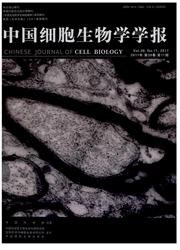

 中文摘要:
中文摘要:
取欧洲鳗鲡Anguilla anguilla尾鳍进行体外培养,最终获得可连续传代的类纤维状的细胞系(欧洲鳗鲡尾鳍细胞系,European eel fin cell line,EEF)。探索不同传代比例对其生长增殖的影响。同时,以MTT法分析不同生长因子『碱性成纤维生长因子(FGF—basic)、肝细胞生长因子(HGF)、表皮生长因子(EGF)1对其增殖、形态的影响。结果显示:EEF增殖受上述生长因子调节作用很小,但是其形态却与FGF—basic6~添加与否及其来源有很大关系。EEF细胞系的生长周期较目前所报道的欧洲鳗鲡细胞系快。染色体数目分析得出EEF6~j特征染色体数目为38条,这是首次基于体外培养细胞系的欧洲鳗鲡染色体数目分析。EEF的增殖、生长特性使之适宜于进一步开展鳗鲡病毒学、细胞生物学、基因组学、遗传学以及资源保护等方面的研究。
 英文摘要:
英文摘要:
The caudal fin of European eel Anguilla anguilla has been successfully cultured in vitro, and the fibroblast-like cell line could be subcultured serially, which was named as EEE In this study, the impact of different passage ratios on EEF's growth and proliferation was examined. Meanwhile, MTT assay analysis was employed to evaluate the effect of different growth factors including basic fibroblast growth factor FGF-basic, hepatocyte growth factor HGF, and epidermal growth factor EGF on proliferation and morphology of EEF. The results showed that the impact of different growth factors on the proliferation of EEF is insignificant, whereas there is significant effect of FGFbasic on the morphology of the cell line. Also the growth rate of EEF was faster than current available cell lines derived from European eel. Karyotype analysis of the cell line shows that the EEF cell has 38 chromosomes. It is the first time to report chromosome analysis based on the cell line cultured in vitro of European eel. In conclusion, the EEF is a suitable cell line for further research in cell biology, genomics, genetics and resource protection of European eel.
 同期刊论文项目
同期刊论文项目
 同项目期刊论文
同项目期刊论文
 期刊信息
期刊信息
